When was the last time you clicked over to Facebook or Instagram and scrolled through your feed? How did it make you feel? Was it cringe-worthy or were you pleasantly surprised?
It can be a scary proposition to analyze your social media performance, but without an audit, there's zero room for improvement. So how do you get started? What data should you track? Which metrics truly matter? What goals should you set?
I've broken down 8 steps to help you measure each aspect of your social media performance. By the time you're done, you'll have a clear picture of:
- What's happening with your business online
- How to edit, tweak or update necessary elements
- What to do to improve performance
Plus, see how you can use that information to supercharge your results. Listen to this episode of the Brand Authority podcast and read the extended show notes below.
Subscribe to Brand Authority Podcast on iTunes
It was Lewis Carroll that wrote, "If you don't know where you're going, any road'll take you there." That exchange between Alice and the Cheshire Cat is as relatable today as the day he wrote Alice's Adventures in Wonderland.
The moral is this: you can't move forward productively if you don't know where you're going and to do that, you need to know where you've been.
That's where qualitative and quantitative social media data comes in. It's a review of engagement, content, community, and your competition. Let's dive in!
Step 1: Assess each channel
Go to each social channel and review how it's performing. Look to your analytics and insights to find:
1. Post Performance
- Engagement: number of people participating in the conversation
- Reach: total number of unique views
- Impressions: how many times your content is displayed
- Website Clicks: number of clicks through to your content
2. Share of Voice
This is the conversation happening in and around your company vs. the competition. Moz offers a simple equation to identify share of voice:
- Brand advertising ($ or #) / Total market advertising ($ or #) = Share of voice
3. Post Types
- Video, images, text - what type of content performed best across each channel?
4. Conversions
- How many people clicked on your social media content, subscribed, and at some point, become a customer?
- Use Google Analytics to find this information. Log into your account and go to: Acquisition - Social - Conversions.
Step 2: Identify your core channel
After you review each channel, determine which one stood out. Was it YouTube, Instagram, Facebook? Make note of the channel performing best and what patterns from the data above begin to emerge.
For example, if YouTube is your top performer, what specific content resonated most? Was it long-form, short-form, quick tips, how-tos? This is great insight into the needs of your audience and their appetite for your content.
As you go through this, don't get caught up in the belief that you have to be everywhere and everything to everybody. Social media user numbers or the popularity of any one social network don't matter. What matters is where your audience is hanging out and actively engaged.
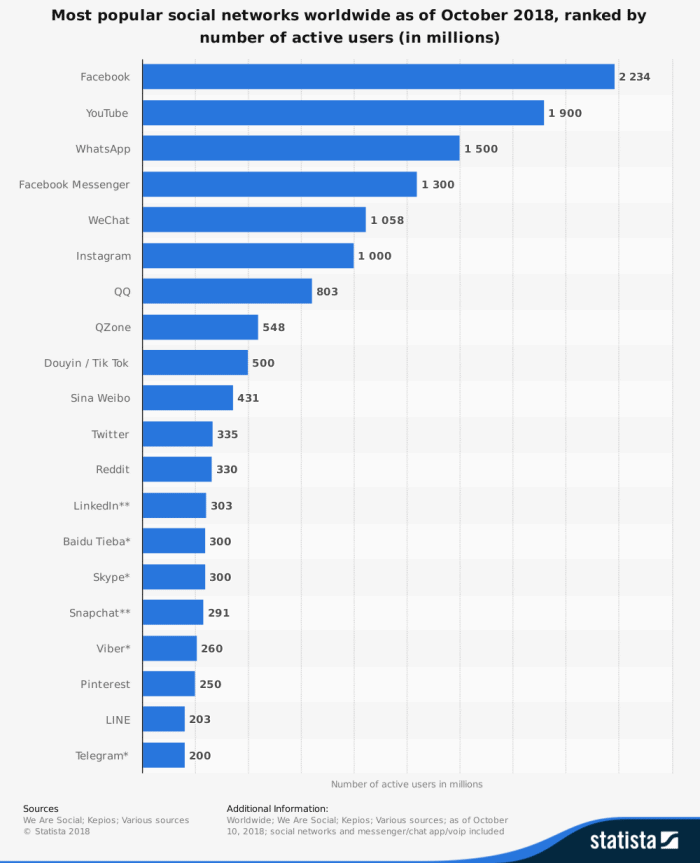
Step 3: Look at your content
Now look at your content and how it flows from one channel to the next. For example, if your home base is your blog, then all content should initiate there and flow to each of your social channels. Ask yourself:
- Is there a natural and obvious order to how and where your content is shared?
- Do you follow a system or process that guides your audience to the next step you want them to take?
- Is your content connected to all of your products or services in a linear and sequential order?
- Does your content directly align to what you're known for (expertise) and your solution (problem you solve)?
If not, you’ll have a random collection of content that does nothing but create confusion in the mind of your audience.
Step 4: Review your social media goals
Do you have clearly defined social media goals? Are you capturing them in a document for consistent review? If not, you're doing your company a huge disservice.
More than likely, you're making broad assumptions, thinking (or believing) you're on the right track. In reality, you have no idea how your performance is helping you reach specific goals.
Instead, make a commitment to look to your data. Create goals that support your high-level company objectives.
The key to this, and whenever you're writing high-performance goals, is to tie the objective to the outcome. In other words, what do you want to achieve and once achieved, what does that look like?
For example, if you're an entrepreneur who creates educational content (online courses), your company goals might look like this:
Objective:
- Hit annual revenue of $1,000,000
- Reach monthly recurring revenue ($ MRR) for membership site of $500,000
- Get over 1000 new signups to current online course (pillar or signature product)
Now you'll roll your online course goals up into those so everything you do (and create) leads you one step closer to your overarching goals.
Objective:
- Retention from initial online course purchase is 60%, and purchase to secondary online course is 95% every month.
- Increase lead (student) conversion rate by 21%.
The last step is tying those objectives to your outcome.
Outcome:
Example:"When I increase my lead conversion rate by 21%, I'll add over 1000 new signups to my current online course, and hit my monthly recurring revenue goals of $500,000."
Step 5: Analyze your listening strategy
Listen to earn trust
Listening is an acquired skill, but a required one if you want to succeed at social media. Mcdonalds' is a great example of how social listening allows you to build trust, increase customer satisfaction, and create a connection between you, the customer, and your brand.
As we know, there's always two sides to a listening strategy: you and your audience. To get started with your listening campaign, let's first define your “social interaction” goals. Answer these questions:
- Who is my customer?
- How am I reaching them?
- Do they care about my message?
- Are they listening?
If they’re not listening, you've no doubt given them a reason to tune out. The analysis above will not only give you insight into your content, but how you should present it.
Listening and consistent testing is how you gain massive clarity.
Listen to Understand
I test my social content on an ongoing basis. I'm looking to determine what my audience wants more of, is asking for, and is ready to consume. A while back I began to share text-only tweets, no image, no link, just thoughts. My audience told me they liked them, so I continued to test.
Today, this type of post is one of my top performers.
4 Ways to Boost Your #Twitter Engagement
1. Stop talking about you: solve audience problems, don’t broadcast.2. Share something new: people are drawn to fresh ideas. Use yours to inspire.3. Get involved. If you post & run, people will take notice.4. Be consistent. #smm— Rebekah Radice (@RebekahRadice) January 3, 2019
Listen to Build Relationships
The second part of social listening is (wait for it...) to be a good listener! :) Take a good look at each of your social channels:
- Are you responding to comments on each channel?
- Are you engaging with your audience on a daily basis?
- Do they feel that you're accessible and interested in what they have to say?
If the answer is no, it's time to make a few adjustments.
A 2018 cont. rule for 2019: If you have 10k+ followers, claim to be an social expert, & don't engage AT ALL w/your community like @JoelRRenner @vincenzolandino @ChrisStrub @MarshaCollier @JuliaEMcCoy @CardozaGab @RebekahRadice @adamsconsulting you bet your ass I'm unfollowing you pic.twitter.com/ERsp7Omvrc
— An-GELI-ca (@matageli) January 6, 2019
To get started, set up your social listening tool. The one I use every day is Brand 24. Use my link for a free trial and see how easy it is to monitor your keywords, phrases, and topics. With the click of a button, you can listen, respond, and monitor brand affinity. Guaranteed, if you're not interacting with your audience, your competition is and that's a huge opportunity lost.
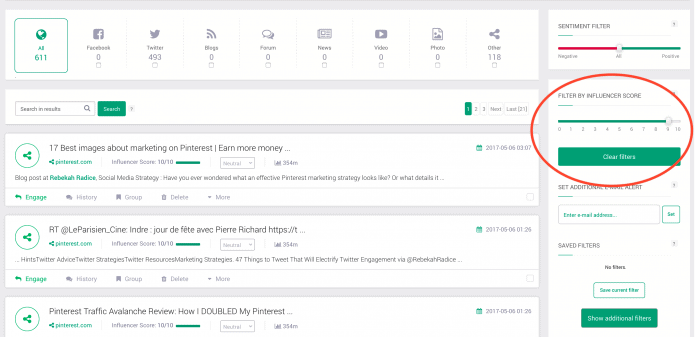
Step 6: Go deep into competitive analysis
To get an understanding of both your competition and the motivation of your social media audience, start here:
- Look at your top competitors social channels, read their posts and comments.
- Document what you see: what are their sharing, creating, and saying on social media?
- How does their brand, messaging, and tone make you feel?
- How is their audience interacting with their content?
Pick 4 or 5 competitors to get started. This will give you a solid overview of what your (their) audience is eager to consume and already actively engaging with.Learn from their success and use it as motivation.
Step 7: Make sure your metrics still matter
As you look at performance, pay special attention to your current metrics. Social media moves fast, what worked for you last year or even last month, may not work based on your current goals.
But don't make the mistake so many make and get caught up in the "fuzzy" vanity metrics that make you feel good, but don't drive your business forward. Instead, focus on the actionable metrics that make a difference to your business. My favorite tool for tracking social media metrics is SEMrush. With their Social Media Toolkit, you can easily create drag-and-drop reports including competitive analysis, social engagement, and overall performance.
Check it out for free and add it to your daily social media strategy.
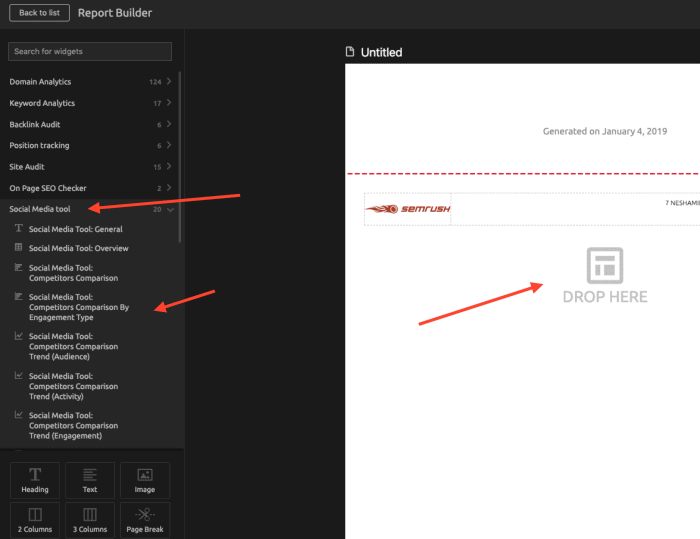
Step 8: Optimize your assets, profiles, and platforms
A social media audit will also help you maintain consistency across your social media channels. It ensures that there isn't any outdated information or unmaintained profiles that need tidying up. Here's a quick checklist to help you work through the optimization of your social networks.
1. Your Name
Is your name the same across all of your online profiles? Are you making it easy for people to find you? Look at your URL or handle (@rebekahradice), cover image, and name within your profile. If you force people to question whether or not it's you or your business, they will click away.
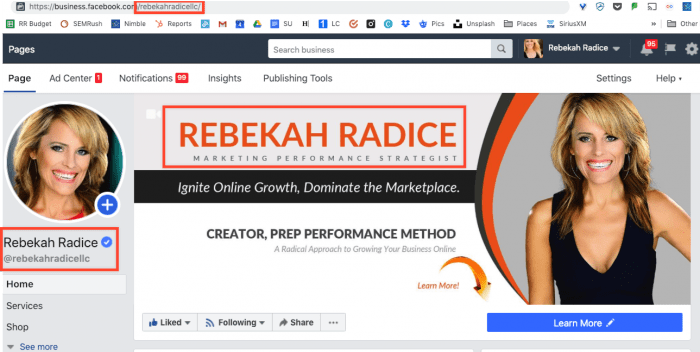
2. Bio
Your bio is the first thing people see when they land on your social profiles. When was the last time you updated yours? If you’ve spent time agonizing over what to write, how to write, and what to include – here’s the only formula you need.
- List one thing you love to do every day (how you help your target market).
- Write down the person you help (who should hire you based on how you help).
- Explain your solution (how it solves the problem of your target market).
Need more help? I broke it all down here.
3. About Section
Some networks like Facebook and LinkedIn give you a lot of real estate to work with, so use it wisely. Clean up any information that's no longer relevant, check that your contact information is up to date, and test any links to your:
- Website
- Blog
- Landing Pages
- Webinars
- Slidedecks
- Courses
4. Profile Picture and Logo
Have you ever left someone's website, looked them up on Instagram and Facebook only to find a grainy, old, and unprofessional headshot? You have one chance to make a great first impression. Pick a headshot or logo that's the best representation of you or your business. Next, share it across all of your social channels. You want consistency!
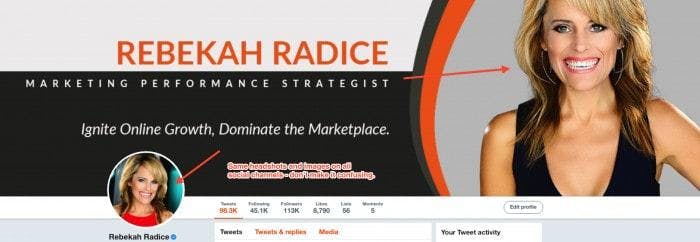
5. Brand Story
Your brand story, when done right, establishes authority. It also creates differentiation. It’s the separation between you and the competition that’s necessary in our online world. It's also the reason one person can turn an audience into raving fans and those fans into clicks, comments, likes, and purchases while another fails miserably. If you’ve struggled to find your voice, tell your story, and leave your mark on the world, take a look at what I wrote here. It will help you get those thoughts out of your head and into a story that sells.
6. Unique Selling Proposition
If I asked you what you do, would you know how to answer? And better yet, what if I asked what sets you apart? More than likely, you’d fumble around for the right words before you spit a few out. You’d later regret not knowing how to succinctly express what makes you unique. To avoid that from ever happening, read this to learn how you can create your own USP and outshine the competition.
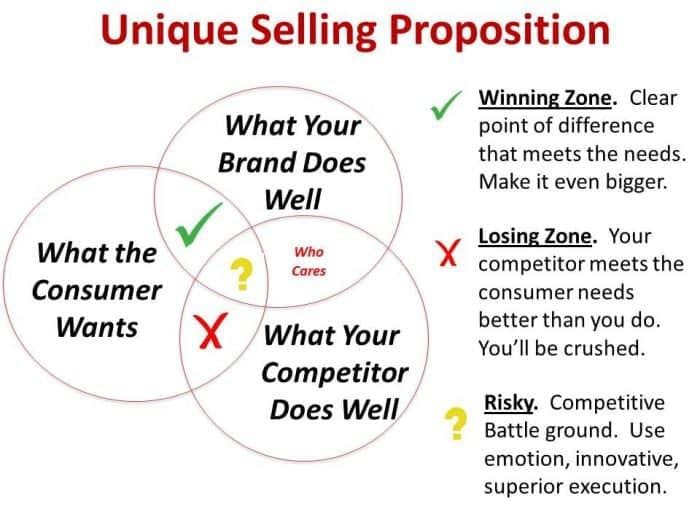
7. Website and Blog
Everything from your website theme, design, content and structure tells your business's story. What story is yours telling? If it screams old, outdated and obsolete, it’s time to clean house and make a change. And when you do, make sure it aligns with your brand message, mission, and vision. If you haven't set your website or blog up yet, Darren Rowse, Founder of ProBlogger suggests you start with these 5 steps:
- Choose your blogging platform
- Secure a domain name and get hosting in place
- Configure your blog
- Design your blog
- Start creating useful content that serves readers
8. Lead Magnets
A lead magnet is anything at the top of your funnel that naturally guides people towards your offer or service. This lead magnet should help people get to know you, moving them into your email list so you can nurture that relationship. If you're just getting started, brainstorm what you can create that directly aligns with two things:
- What you’re known for (want to be known for)
- Your solution (how you solve their specific problem)
As you begin to build out your lead magnets, keep them in logical and sequential order. You want to move people to opt in, giving them one piece of relevant content after the next.
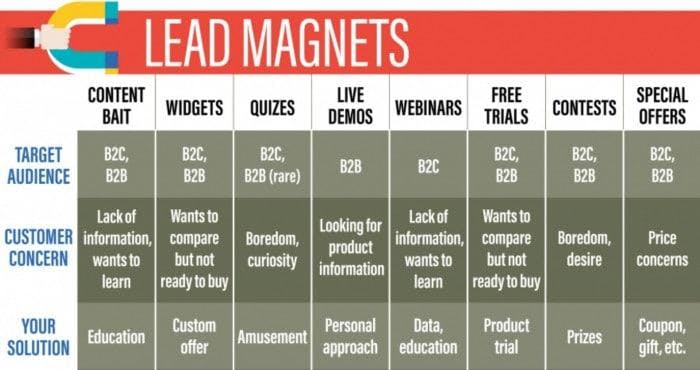
9. Content Marketing
Pam Moore, Founder of Marketing Nutz, recently wrote:
Content is at the core of our digital and social, always on, always connected and always learning mobile world of communication.
Absolutely! And yet, only 39% of businesses have a documented content strategy in place. If you haven't taken the time to design what your strategy looks like, read my 8-step formula to get a jumpstart.
10. Source of Leads
Review your analytics often to determine what channel is:
- Driving the most leads
- Converting at the highest rate
Also, look at the weakest channels to see if there's a leak or block preventing the leads from moving down the funnel. The easiest way to track your source of leads is to use UTM Parameters. Not familiar with UTM tracking? This is the best way for you to see what content is showing up on social and how it's performed. Use the Google URL Builder to start tracking.
Here’s how you do this:
- Add the URL to the piece of content you're promoting.
- Add Campaign Source (Facebook, Twitter, Instagram)
- Add the Campaign Source: I use this to describe what type of content it is.
- Add Campaign Name: Be specific so there's no questioning down the road.
- Add the URL to each social media post.
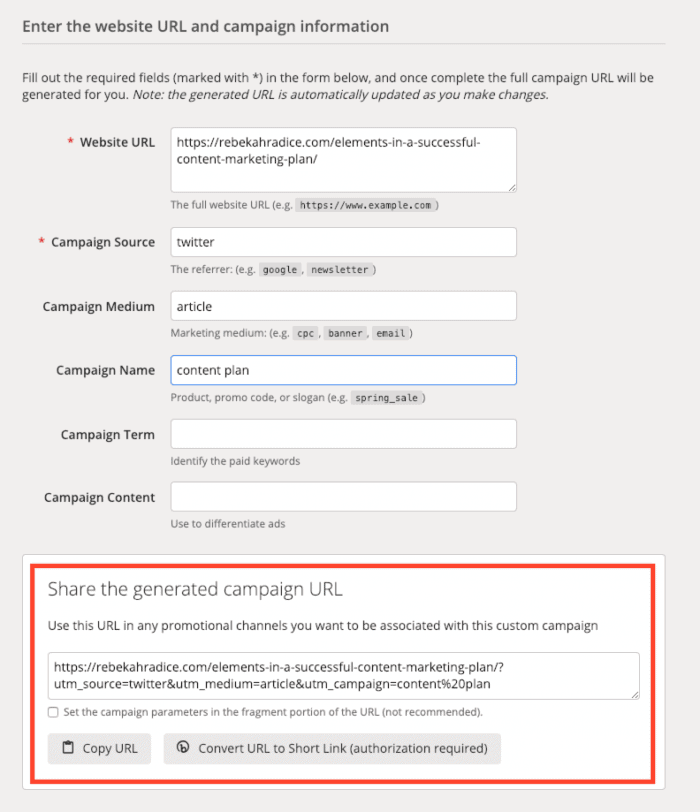
Final thoughts
The next time you feel like social media isn't working for your business, go through this 8-step process. It's an eye-opener! Instead of making broad assumptions that lead to a distorted view and poor decisions, get a clear picture of what's really happening. I don't promise that running this audit will always be fun, but the insights will be invaluable!
Subscribe to the Brand Authority podcast
People, brands and resources mentioned:
Episode 21: 3 Ways to Set Achievable Social Media Goals For Your Business
Episode 24: How to Easily Develop Your Content Marketing Strategy
Want to view on YouTube Instead?
About Rebekah Radice
Rebekah Radice, co-founder of BRIL.LA, has traded narcissism for purpose. When not driving growth, you'll find her tricking family into thinking she's Emeril Lagasse - likely covered in marinara. The spotlight was fun, but impact is better. These days she's using 20+ years of brand brilliance for good.
